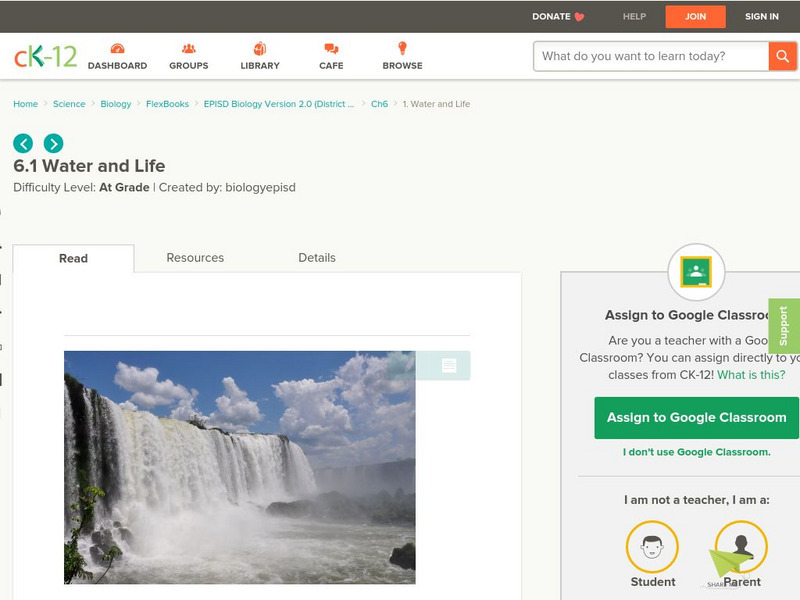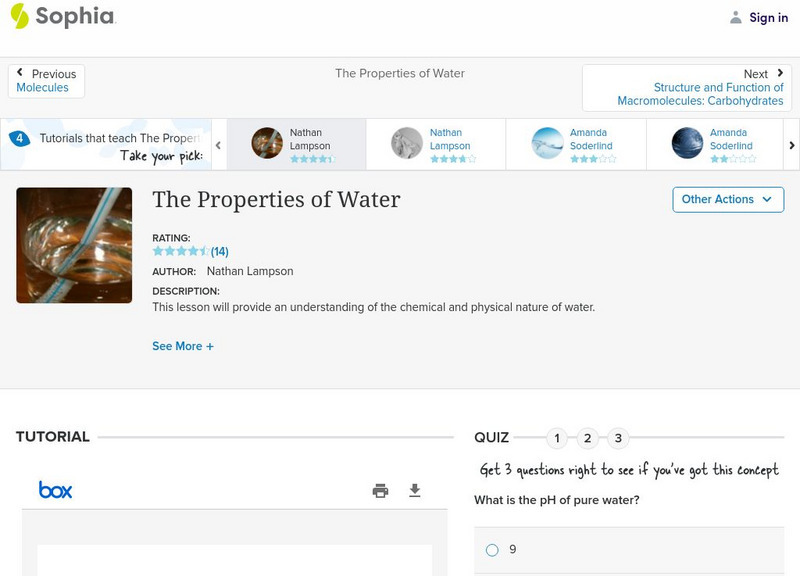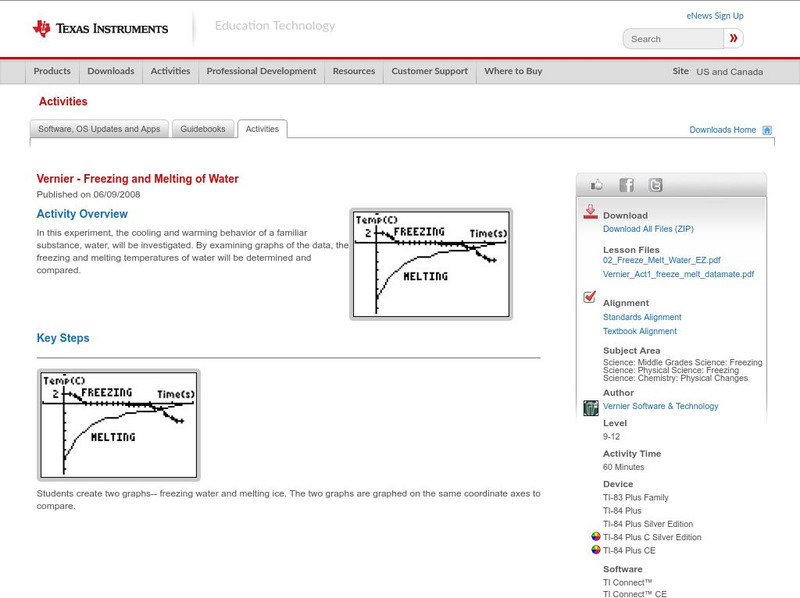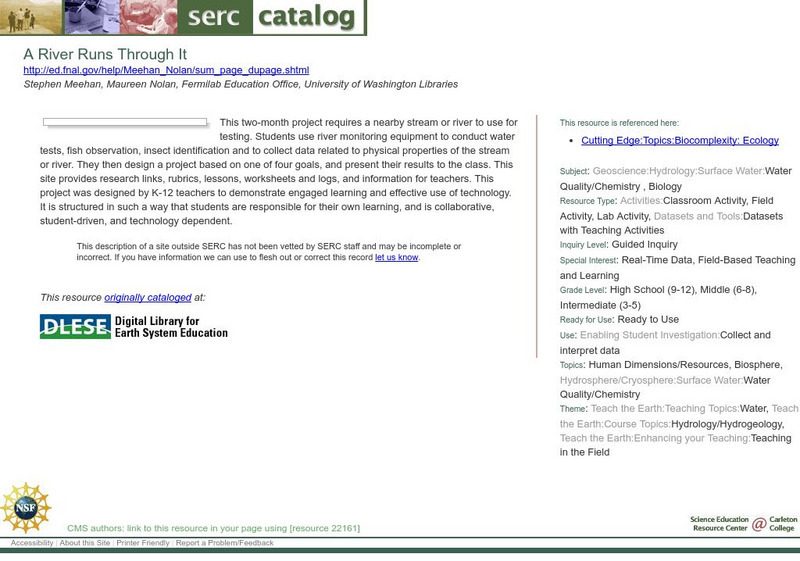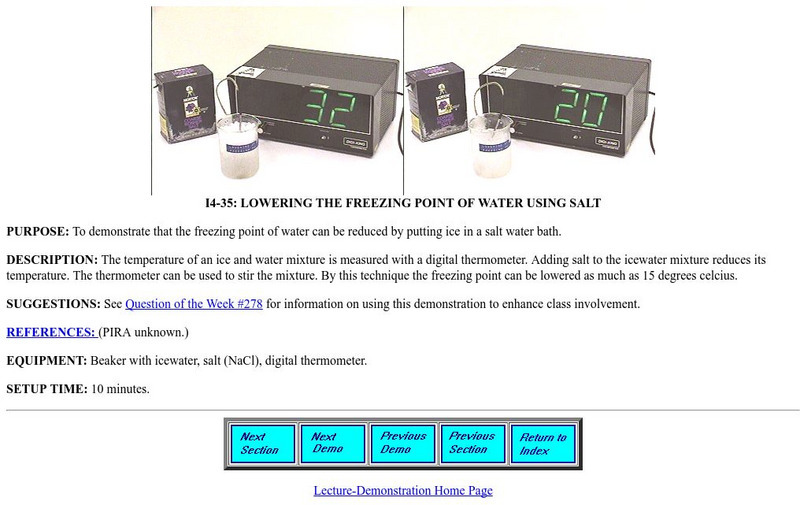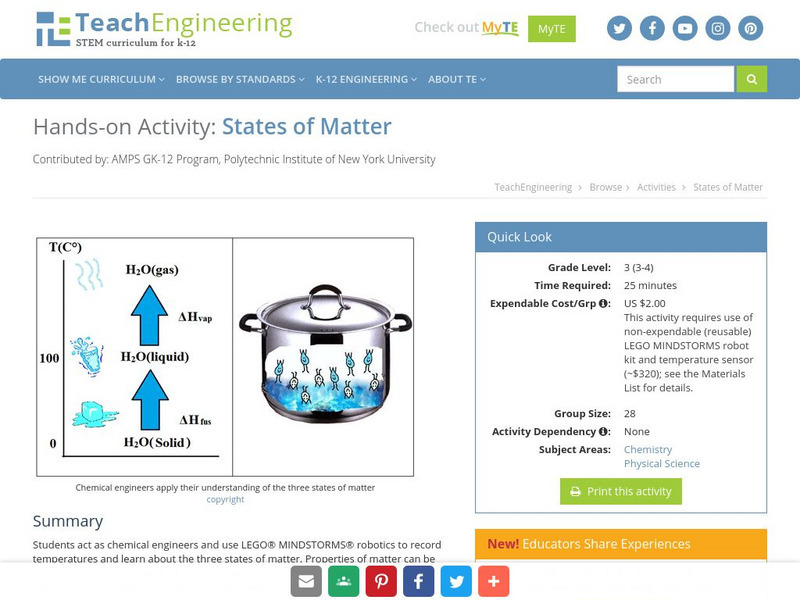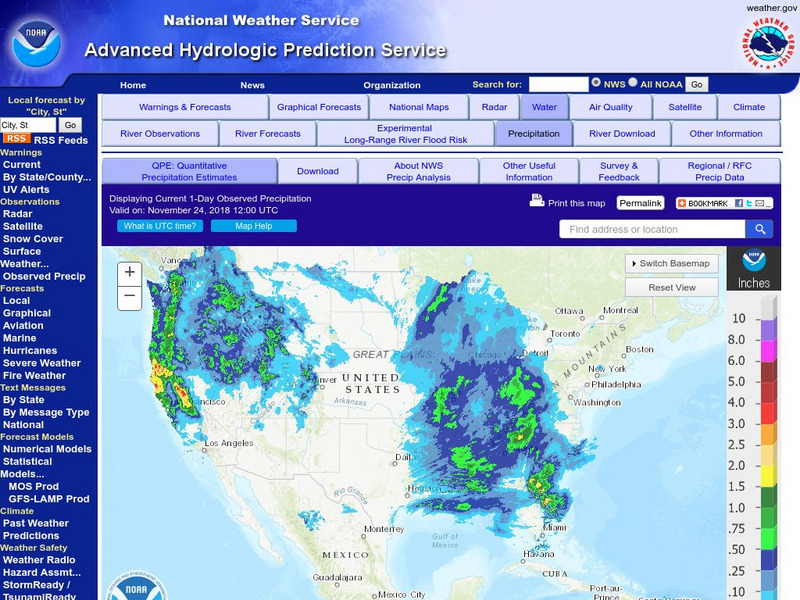CK-12 Foundation
Ck 12: Chemistry: Physical Properties of Water
[Free Registration/Login may be required to access all resource tools.] Covers physical properties of water, hydrogen bonding, surface tension, and vapor pressure.
Science Education Resource Center at Carleton College
Serc: Physical and Chemical Properties of Water
In this lesson students will understand the difference between chemical and physical properties by studying the properties of water. Students will also understand how to perform the different laboratory techniques that go along with the...
CK-12 Foundation
Ck 12: Properties of Water
[Free Registration/Login may be required to access all resource tools.] Students look at the chemical structure of water and learn how it determines water's properties.
US Geological Survey
Water Properties
This site provides a discussion of the physical properties of water. Click Home to access the site in Spanish.
CK-12 Foundation
Ck 12: Water and Life
[Free Registration/Login may be required to access all resource tools.] The chemical and physical properties of water are examined in this lesson, including the role of hydrogen bonds in determining water's properties. The importance of...
Sophia Learning
Sophia: The Properties of Water: Lesson 3
This lesson will provide an understanding of the chemical and physical nature of water. It is 3 of 4 in the series titled "The Properties of Water."
Sophia Learning
Sophia: The Properties of Water: Lesson 4
This lesson will provide an understanding of the chemical and physical nature of water. It is 4 of 4 in the series titled "The Properties of Water."
Sophia Learning
Sophia: The Properties of Water: Lesson 1
This lesson will provide an understanding of the chemical and physical nature of water. It is 1 of 4 in the series titled "The Properties of Water."
TeachEngineering
Teach Engineering: How Cold Can You Go?
Students explore materials engineering by modifying the material properties of water. Specifically, they use salt to lower the freezing point of water and test it by making ice cream. Using either a simple thermometer or a mechatronic...
Texas Instruments
Texas Instruments: Freezing and Melting of Water
Freezing temperature, the temperature at which a substance turns from liquid to solid, and melting temperature, the temperature at which a substance turns from a solid to a liquid, are characteristic physical properties. In this...
Science Education Resource Center at Carleton College
Serc: A River Runs Through It
This two-month project requires a nearby stream or river to use for testing. Young scholars use river monitoring equipment to conduct water tests, fish observation, insect identification and to collect data related to physical properties...
Indiana University
Indiana University Bloomington: Reference Documents: Calcite [Pdf]
A fact card describing the characteristics of calcite and its presence in limestone, its chemical and physical properties, and the composition and structure of a calcite unit cell.
Physics Aviary
Physics Aviary: Practice Problems: Flow Rate From Beverage Dispenser Problem
Students determine the flow rate and speed of the water leaving a faucet based on the properties of the beverage dispenser that it is coming from.
Indiana University
Indiana University Bloomington: Is It a Rock or Mineral? [Pdf]
In this lesson, young scholars will compare types of candy to learn about geological classification. Students will classify and sort different materials by their composition and physical properties.
Indiana University
Indiana University Bloomington: Fossil Identification Chart [Pdf]
A flowchart students can use as a tool to identify fossils based on their physical characteristics, e.g., segmentation, symmetry, lack of a skeleton, etc.
University of Maryland
Lowering the Freezing Point of Water Using Salt
A page from the University of Maryland Physics Lecture Demonstration Facility. Provides directions for a teacher demonstration of the effect of an ionic solute upon the freezing point of water. Shows apparatus and set-up; provides...
TeachEngineering
Teach Engineering: States of Matter
Students act as chemical engineers and use LEGO MINDSTORMS NXT robotics to record temperatures and learn about the three states of matter. Properties of matter can be measured in various ways, including volume, mass, density and...
American Chemical Society
American Chemical Society: Best of Wonder Science: Ice of a Different Color [Pdf]
An experiment to test what happens to water when salt or sugar is added and it is then frozen into ice cubes. Students also explore the ice's physical properties by rubbing cubes on sandpaper and dropping a heavy object on each type.
National Weather Service
National Weather Service:climate Prediction Center: Daily Precipitation Analysis
Find real-time daily precipitation analysis for the United States, Mexico, and South America as well as accumulated precipitation maps for the past 30 or 90 days.
Museum of Science
The Atom's Family: Phases of Matter
Help the Phantom choose a material and observe the changes at different temperatures in the molecule chamber. What happens to the elements or molecules as the temperature changes?
Indiana University
Indiana University Bloomington: Geo Notes: Composition of Coal [Pdf]
Discusses the chemical and physical composition of coal and why understanding the chemical properties of coal is important for knowing how to process and use it.
ClassFlow
Class Flow: Forces Land
[Free Registration/Login Required] This flipchart describes physical characteristics of landforms and bodies of water including mountains, plains, plateaus, valleys, rivers, bays, and lakes.
Other
Us Peroxide
US Peroxide is the leading supplier of hydrogen peroxide and peroxygen based technologies and services for environmental applications. Their site includes information about hydrogen peroxide such as common applications, physical and...
Texas Instruments
Texas Instruments: Forensics Case 8: Using Soil Characteristics to Link Suspects
In this activity, students measure pH, conductivity, and water absorbency of different samples of soil. They use these characteristic properties to identify soil samples. They use the physical and chemical characteristics of soil samples...




